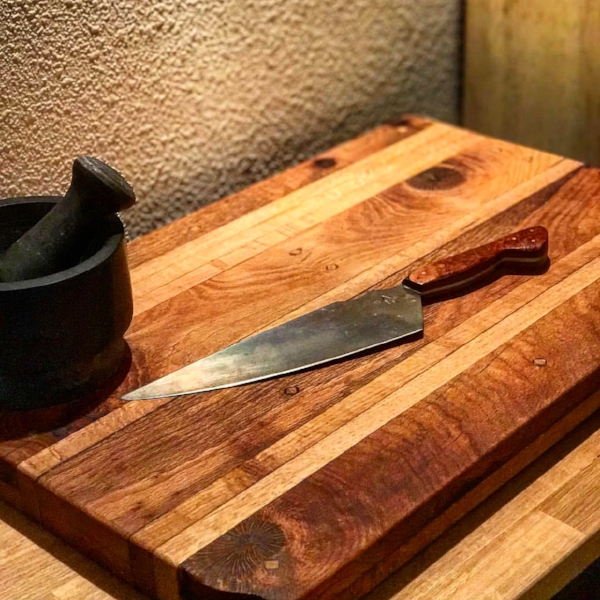Knife Care and Use
First off…about the blade-it is sharp!
High Carbon Stainless Steels (440C, AEB-L , AEB-l NitroV, S35vn...) -
These blades need to be hand washed and towel dried, no dishwasher! Aside from that, these blades give you the best of both worlds! If you're concerned with the maintenance of straight high carbon steels this is the option you will want to select. Stainless steels were once considered inferior to carbon blades, and while some carbon blades can get slightly harder, improvements in modern stainless alloys have all but closed the gap between these two styles of steel. Our AEB-L steel is top of the line and will outperform many of the straight carbon blends.
High Carbon - Non Stainless steels ( 1095, 52100, 80CRV2, 1080 ...)
For our culinary and outdoor knives being used for food prep and game cleaning duties please rinse and dry with a towel immediately after use. NO dishwasher! If allowed to drip dry, it will rust. Didn't listen and left it on the counter covered in onion juices, didn't you? Not to worry! Use a no scratch scrubbing pad or fine “0000” steel wool with running water or a light cooking oil for lubrication. Lightly rub the blade until the surface rust has been removed. Remember, sharp knives bloody cuts! Once you have run through your first few meal preps, the knife will build a protective layer that will keep this from happening, but until you run through some onions, potatoes, and fruit salads, a little extra diligence is necessary. While not 100% necessary blades can be wiped with cooking oil or mineral oil to help prevent oxidation. Your knives will develop a story, or patina, with use. These are high carbon, low alloy steels. Not stainless-steel-blades. Once the patina has fully developed it will protect the blade and help prevent rust and oxidation. To really get a kick start on that knife-story, chop up a bag of onions. Cry a little, it's ok.
A knife used primarily on vegetables will develop bold stripes and patterns. Meat choppers, like our cleavers, will gain a translucent hue. If it rusts, use a Dobbie pad, steel wool or even metal polish and a cloth to buff it out. Hold the knife securely, we don't want you to hurt yourself.
Storage and Meal Prep
We really suggest storing your DogHouse knife (or any knife) on a magnetic knife block where it can quickly dry. Check the “Home” shop if you need one to see the available options! Also, use a wooden or plastic cutting board. No glass, tile, ceramic or lead cutting boards. You know better!
Sharpening -
Keep it sharp. We like water stones, but you don't have to keep a small fortune worth of smooth rocks in your cupboard to maintain your knifes edge. A good combo stone will do the trick. "King Water Stones" makes a great 1000/6000 grit stone for maintenance work that retails for around $35, and an 800 grit for re-cutting your bevels if necessary. Stone sharpening videos are readily available online.
You can also use a ceramic hone or SELECT! draw through sharpeners. Always start with the finest setting and work backwards to ensure only necessary material loss. Be sure that if you are using a dry pull through system that you invest in one that lets you adjust the blade angles (direct link to our recommendation below) - A couple of swipes once a week or so should be more than enough for those putting their blades through heavy use and for those using a hone you shouldn't really need more than that for regular use.
We ship them sharp because we like you. Like us back and keep them that way. If things get ugly, ship it back (on your dime) or meet us at the shop and we will reset and sharpen them for you. For directions, mail delivery, and appointments to meet at the shop please email us directly: Emily@doghouseforge.com
Handles - Almost all of our handle materials have been stabilized and as such will not adsorb moisture. The wood should not change in any way during the life of your knife. These stabilized materials are sealed with a protective clear coat and can be touched up with any lacquer or Poly-Crylic base clear coat, should you want to freshen it up later. Oiling stabilized handle material will not be effective due to the permanent waterproof status.
For natural wood handles, wax or simple mineral oil will be all that is necessary. Butcher block oil, danish oil, and teak oil will also do the trick. We follow the directions written on the can so you can repeat the process exactly as it came to you. Depending on what part of the country (or world) you live in, calcium can build up on the handle from hard water. This can leave tiny "Water spots", typically on the liner sections, and a little elbow grease will remove this without needing to redo the top coat. As always, remember that should you need anything repaired or refinished you can send it back to us and we will fix it free of charge! (minus return shipping cost)
Happy slicing, dicing. and chopping.
Email - Emily@doghouseforge.com

